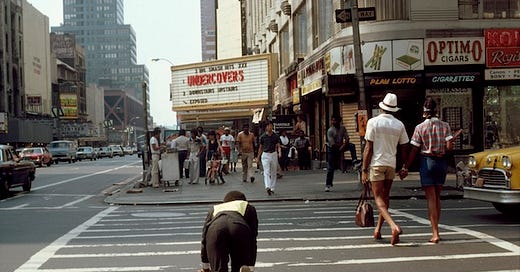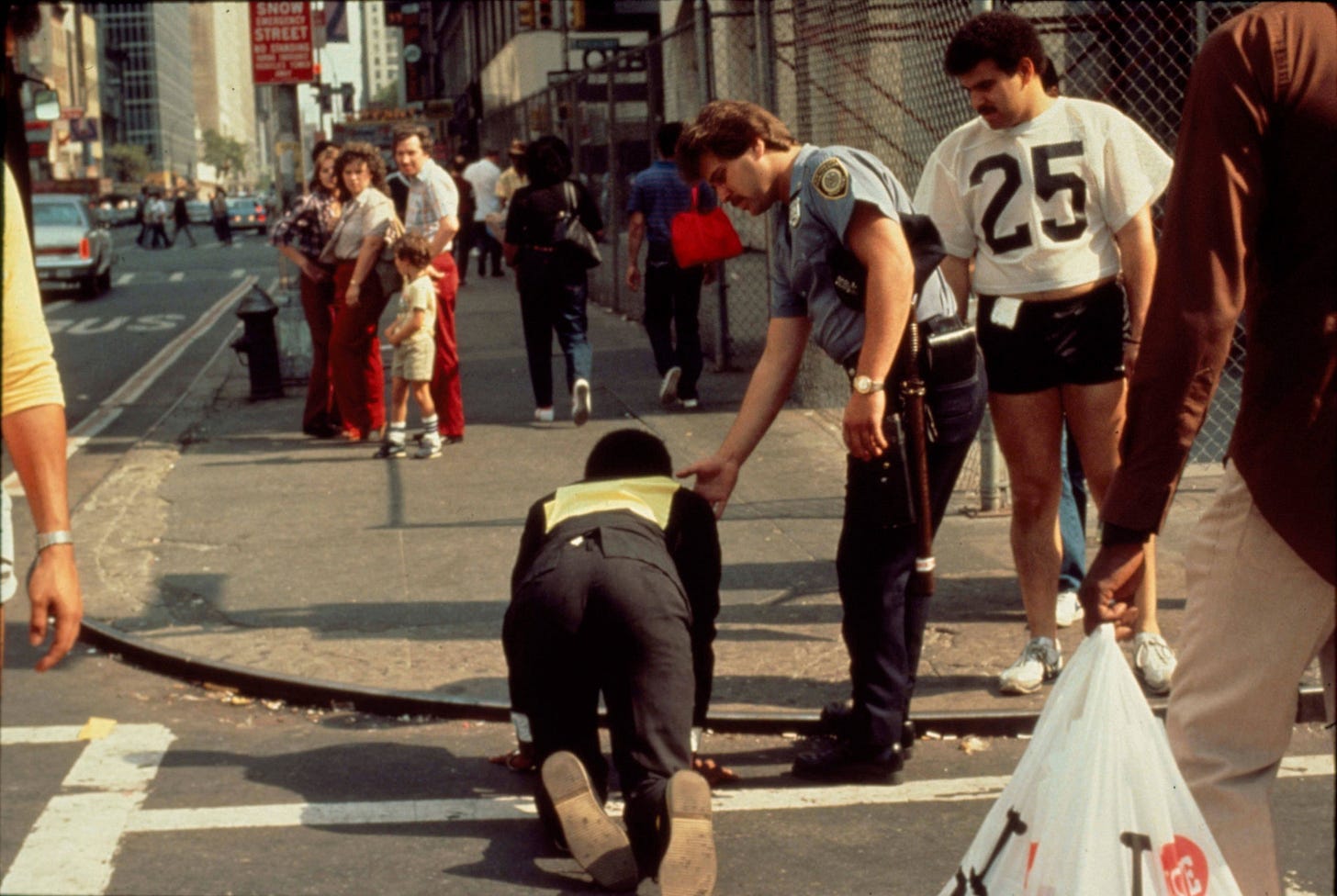“Si no hay cuerpo no hay delito.” If there is no body, there is no crime.
So begins the North American Congress on Latin America’s 2024 report on disappearances and human rights violations across the Americas.
Something is vanishing. Not in a melodramatic, sky-is-falling way (though maybe that too) but in quieter ways. I scroll through my phone for hours and remember none of it. I go to a friend’s art pop-up in Brooklyn and spend more time documenting than actually looking. I wake up and forget what I dreamt, then forget what I forgot. The air feels thicker lately. I’m not sure if I’m living through time or being dragged by it.
Yoko Ogawa’s The Memory Police offers an eerie metaphor for our world. On an unnamed island, things begin to disappear. First small things like birds and roses, then larger ones: the idea of perfume, photographs, novels. When something disappears, the island’s inhabitants don’t just lose access to the object, they lose the memory of it altogether. The Memory Police enforce this forgetting. To remember is to commit a crime.
I read Ogawa’s work in conjunction with Claire Bishop’s Disordered Attention which is not a novel but, in some ways, it diagnoses the same condition. Her subject is not forgetting, but distraction. She charts how attention, its disintegration, manipulation, and commodification, has shaped contemporary art. In a world of infinite “content,” she wonders: what does it mean to actually attend to anything? Bishop argues that the modern subject is pulled in so many directions at once that attention itself becomes something else entirely. We are aware of everything and present for little of it.
Both books, in radically different registers, speak to the condition of contemporary absence. Whether by enforced forgetting or algorithmic fragmentation, something is pulling us away from presence. And that’s not just a personal crisis; it’s also a political one.
In Ogawa’s novel, the island’s descent into forgetfulness is gentle, almost polite. People accept the disappearances as they come. They might mourn briefly, then burn or discard the remaining vanished objects so as to not anger the authorities. They might even act as if it is a sudden relief that something is gone. Actually, it’s for the better. Who needed the stuffy library anyway? The process is bureaucratic, orderly. The Memory Police arrive to search homes, but there’s no need for violence as most citizens comply willingly. They forget, maybe because they have forgotten how not to.
The narrator, a novelist, watches this unraveling with a kind of muted horror. Her mother had secretly hidden lost objects, but she herself struggles to retain their meaning. This is not just a dystopia. It is a somewhat on-the-nose metaphor for how authoritarian regimes manipulate reality: by erasing language, severing historical memory, dissolving the past until only the present that is empty and controllable remains. You can’t resist what you no longer remember. You can’t mourn something you can’t name.
In the real world, this plays out through somewhat (barely) subtler means. School curriculums are rewritten. Historical atrocities are reframed as patriotic. Books are banned. Maps are redrawn. Oceans are renamed. What Ogawa imagines as surreal, we recognize as everyday. The political project of forgetting is already underway.

But what if the problem isn’t forgetting through erasure, but forgetting through excess?
Disordered Attention situates the crisis of attention as a defining feature of neoliberal capitalism. We are bombarded by images, feeds, notifications, and content to the point that nothing lands. Aesthetic overload becomes its own form of forgetting; the more we are asked to look, the less we see.
Bishop traces this through contemporary art, noting how many artists attempt to either reflect this fragmentation or counteract it. Some artworks mirror the chaos: installations that overwhelm the senses, digital media that loops infinitely. Others offer slowness, asking viewers to stay, linger, attend. “Artists no longer undertake their own research,” she writes, “but download, assemble, and recontextualize existing materials in a desultory updating of appropriation and ready-made.” Even the act of creation, then, is shaped by distracted attention: fractured, borrowed, and assembled rather than deeply inhabited.
Bishop is skeptical of whether viewers can keep up. “There is no 'ideal viewer,' only a flow of possible approximations,” she writes. “We might feel obligated to be ‘good’ viewers and make a fair stab at looking at or watching everything in an exhibition, but equally feel overwhelmed and alienated by the amount of material it contains.” Even the most attentive viewer is forced into a kind of triage: a form of attention as survival, not immersion.
This is not just about art. The attention economy is political. The same tools that keep us glued to our phones also train us not to dwell, not to reflect, not to stay with anything. Rage is encouraged, but only the kind that burns out quickly. Long attention, of the kind required to understand history, systems, and other people, is systematically dismantled. What remains is surface, spectacle, scrolling.
The attempt to pierce this numbed attention can be seen in works like the 2018 Turner Prize presentation at Tate Britain, The Long Duration of a Split Second, which was based on ninety-five blurry mobile phone videos of an Israeli police raid on a Bedouin village. The work’s low-res, unsteady, chaotic form mirrors the fractured way we absorb violence today. Bishop includes this as a kind of diagnostic: what does it mean to seek justice through the very mediums that make us numb to it?

Attention, like memory, is a site of struggle. To focus on something, to really stay with it, is increasingly difficult. But it is also increasingly radical. The artist William Pope.L understood this. Beginning in 1978, he crawled around Manhattan on his hands and knees wearing a business suit, using his own body to interrogate public space. Who owns the street? Who has the right to be seen? Presence, here, becomes confrontation. The body becomes the subject, refusing to be erased.
The Memory Police is about absence by force. Disordered Attention is about absence by noise. But the effect is the same: a citizenry unable to hold on to meaning. A body politic stripped of memory, scattered by distraction. Fascism thrives under these conditions.
Fascism doesn’t need everyone to believe, it only needs most of them to forget. To forget what came before, to forget what freedom feels like, to forget that things could be another way. It thrives in the vacuum left by memory and the confusion sown by fractured attention.
Presence is dangerous to it. Why? Presence is noticing. Presence is refusing to look away.
“Maybe there’s a place out there,” Ogawa’s narrator wonders, “where people whose hearts aren’t empty can go on living.” It’s a fragile hope, one that feels more like a wish than anything else.
Much has been said about the banality of evil: the bureaucratic compliance that enables atrocity. But perhaps the more urgent concept today is the banality of forgetting. The quiet erasure of collective memory through curriculum changes, algorithms, and the hollowing out of time.
Presence is not passive; it is a prerequisite of resistance. And it is one thing that cannot be taken unless we give it away.






I'm glad that you write, it fills part of that absence
good job contributing to the work of remembering